Flierl, Luise (1861-1934)
Luise Flierl nee Auricht, a third-generation German-Australian from Tanunda, was associated with the Dieri mission at Bethesda (SA) and helped to found the Lutheran missions in New Guinea. As the wife of pioneer missionary Johann Flierl, she was pivotal in the spread of Lutheran mission outreach into the north.
Background, Childhood and Youth (1861-1878)
Beate Maria Luise Auricht was born in Tanunda, South Australia, on the Sunday of Pentecost, 20 May 1861. Her parents were the children of migrants from Prussia. The mother, Maria Elisabeth, née Paech, was born in Kay, in the Prussian province of Brandenburg. She came to Australia with her parents as a four-year old in 1838.1 Her parents were farmers who had given up their property in Prussia to rebuild a new farm in Hahndorf where they raised no less than ten children, one adult son had stayed back in Prussia.2 Young Maria Elisabeth must have been an industrious woman, who reputedly sheared 45 sheep in a day.3 In 1858 she married Luise’s father Christian Auricht.
He was born in Chlastawe in the Prussian province of Posen, as the son of a blacksmith. Two younger siblings died in infancy and Christian and a younger brother migrated in 1839 at age six and four with their parents. Christian’s parents, like the parents of his wife, were religious refugees. His father had been sentenced to fines and imprisonment because as a committed Lutheran he had resisted the unification of the Lutheran and Reformed churches in Prussia. Eight months after their arrival in South Australia, Christian’s mother died at age 31, presumably in childbirth.4 The father remarried, and the family, to which gradually five more children were added, became one of the pioneer founders of Tanunda.
Christian Auricht was ordained at age 26 in 1858, and married Maria Elisabeth Paech in the same year. He became August Kavel’s assistant and after the death of the latter two years later he became the parish priest in Langmeil-Tanunda for 47 years. He also acted as a printer and journalist. For several decades he edited the Lutheran church newsletter for Germans in Australia, Kirchen- und Missionszeitung fuer Deutsch-Australische Gemeinden and promoted the mission for indigenous Australians. Contemporaries described him as an earnest and faithful man, and in 1900 he was elected the president of the Lutheran Immanuel synod.5
Luise Auricht therefore grew up in a pastor’s household. She had an older brother Gottlieb and every two or three years another sibling arrived: Wilhelm, Berta, Ernst, Johannes, who succumbed to typhus at age 26, Carl, who only lived for six months, and finally baby of the family, Theodor. Luise attended the public school in Langmeil and then completed two more years in a German private high school in Tanunda.6 During this period she contracted typhus, but recovered.7
Their daily lives revolved around the family devotions in the morning and evening and the pastoral work in three scattered parishes, Tanundan, Nain and Sedan. The house almost always containedvisitors, mainly priests and missionaries recently arrived from Europe whom Louise’s parents would put up for weeks and months free of charge, supporting them as well as they could.8
Engagement and Marriage (1878-1882)
Christian Auricht thad the habit of keeping in touch with the young missionaries by mail. Towards the end of 1878 he received a reply from the young Neuendettelsau graduate Johann Flierl, who had been engaged at Bethesda mission for several months, to which the bold farmer’s son from the Upper Palatinate added the request for the hand of the pastor’s eldest daughter. Pastor Auricht replied that Flierl should direct that question directly to the mother and the daughter. This Flierl did, and at Christmas 1878 the seventeen-year-old Luise dispatched her written consent.9
Concerns were raised about what the fragile Luise could possibly accomplish in the Australian desert. But according to Johann Flierl’s memoirs:
“In subsequent years the fragile flower showed that she stemmed from the strong and hardy roots of the Auricht and Paech colonist families, and turned out to be steadfast and resilient in the Australian deserts and later in the New Guinea wilderness, where she truly proved herself and did not shrink back from thorns or adversity.”10
But the wedding was going to have to wait for a few years, and so Luise was inundated with letters and romantic poems from the pen of a young missionary, who also conveyed to her a ring for her 18th birthday.11
One day in October 1880 the young missionary suddenly appeared on the front verandah in Tanunda, and ended up spending several months in the hospitable Auricht home. On the 27th January 1881 the engagement that had been promised two years earlier, was finally ‘confirmed in person’12.
One and a half years later Johann Flierl again rode in from Bethesda. Luise’s mother had declared the 21-year old as having come of age, and the groom had now also reached an adequate age at 24, and there was to be a wedding on 5 October 1882.13
They held a big party with many invited guests including representatives of the large extended family of the Aurichts and Paechs, several pastors’ families, members of the mission committee and their families, and the homeopathic practitioner of Tanunda. Christian Auricht wed the young couple and, standing in the open church door to demonstrate the public nature of their commitment, Luise vowed that
“I will serve and obey you, and care for you, and be loyal and faithful, and never leave you until death do us part.”14
Auricht’s printery workshop had been completely cleared out and made over as a festive wedding venue. After feasting on geese and speeches nearly five pound sterling were collected for the mission. In the afternoon the bridal couple undertook an excursion with the younger guests into a nearby valley to the refreshing waters of the Gawler brook that sustained the fertile orchards and kitchen gardens of the colonists. On the following day the wedding celebration ended with another excursion by all the remaining guests, young and old.15
A few days later Luise took leave from her parental home, to accompany her missionary to Coopers Creek, an inhospitable, lonesome place in the remote north of South Australia, where the Dieri mission had been stagnating for decades.
Missionary wife in Australia (1882-1888)
The young couple left by train, and then buggy to Bethesda where a three-room cottage consisting of study, bedroom and kitchen had been prepared for them.16 Luise had to acclimatize herself to these new surrounds and make them her home. The strong winds whipping the sandy soil in the unrelenting sun triggered a severe eye infection straight away. Her eyes became so ulcerated that she could not see at all and was gripped by the fear of loosing her eyesight. This terror moved her to tears, which opened her lids again, and her eyes began to heal. Notwithstanding the adverse conditions of the isolated mission, Luise adapted well and was soon in charge of the small dairy herd and dairy production including goats and chickens, as well as the riding and pack horses and a dog. She looked after the household, did the laundry, instructed the indigenous girls in sewing, and played the harmonium during mass.17
While her husband was away for months at a time trawling through the desert to seek ‘untouched tribes’ that could be missionized, Luise remained back at the station worrying.18 Her mother came to keep her company for three months, then her younger sister Bertha came, and in 1883 she herself went back to Tanunda for several weeks.19
Her sense of isolation was not lessened through the presence of three other white women. The other staff on the mission were the teacher, Rev. Carl August Meyer and his wife Emma Louise, who moved to Hopevale Mission in 1886, and the lay missionaries Ernst Jacob and Heinrich Vogelsang. Vogelsang was married to his second wife and had one child staying at the mission. The Jacobs lived some distance from the mission to supervise the cattle herd, and later occupied the house vacated by the Flierls.
When news hit the papers in 1885 that the German Reich had acquired the north-eastern part of New Guinea as its colony in the south seas, Johann told his wife one day that he had just written to the mission director in Neuendettelsau offering to undertake the first missionary attempt in this unknown country. Luise complained “I’ve already gone to the Australian desert, and now I’m supposed to go into the wilderness of New Guinea as well!’20
Finally an arrangement was made which in the end caused a long separation. Luise returned to her parents in Tanunda while her husband set off. As it turned out, he was held up for several months at Cooktown in north Queensland, during which time he founded the Elim (Hope Valley) mission station. It was 1886 before he managed to travel to New Guinea and he finally went to fetch his wife two and a half years later.
New Guinea (1888-1930)
Luise Flierl arrived in New Guinea on 8 June 1888. At Simbang mission station she was afflicted with severe tropical fevers that attacked her every couple of weeks to begin with.21 Still, she had to look after the household and under extremely difficult living conditions she also had to provide for the unmarried missionaries and the frequent visitors, as well as do the laundry, care for sick patients, and look after the goats, chickens, pigs and cows.22
Eight years after they got married their first daughter Dora was born on 22 August 1890. The newborn suffered severely from fevers, was weak and did not thrive. Luise considered saving the baby by taking her back to Australia. But her husband refused to allow her to depart from what he considered their joint responsibilities in the mission field, so instead, the whole mission station was shifted from the humid coastline higher up into the mountains.23
Three more children arrived in quick succession: Wilhelm in 1892, Elise in 1894 and Hans in 1895, at whose birth Luise nearly died.24 Dora seemed slow in her development, and learned to walk at the same time as little Wilhelm did.
They undertook another two strenuous removals: from upper Simbang to Sattelberg, and finally to the new mission at Heldsbach. Luise worked as missionary wife for 48 years, during which time she only left New Guinea twice: in 1889/1899 for a visit to Australia with the whole family, and from 1908 to 1911 with her husband in Germany and the USA.
Retirement in Tanunda (1930-1934)
All her married life Luise had been following her husband – now in retirement he resolved to settle in her Australian homeland rather than return to Germany. In September 1930 they took leave from New Guinea and moved to South Australia. After a period in Melbourne and then with Luise’s sister Beate in Tanunda, in the summer of 1931/32 they settled into the ‘New Guinea Haus’ in Tanunda. The site had been donated by the Langmeil parish and the Flierls spent all their savings, including all the gifts received for Johann’s 70th birthday, supplemented with funds from the synod. The house was decorated with shells and artefacts from New Guinea and has now become the Luise Flierl Museum in Tanunda. Many friends, acquaintances and relations came to visit them there, and Luise and Johann on their part also did much travelling to visit their erstwhile companions.2525 On 5 October 1932 they celebrated their golden anniversary in the church that had now replaced the one in which they had been married.
One year later, in October 1933, Luise suffered a stroke.26 She made a good recovery but could no longer undertake extensive excursions like her husband did. Still, she continued to walk to the nearby church every Sunday. Exactly one year later she suffered a second stroke and did not regain consciousness. She died on the afternoon of 5 October 1934, on her 52nd wedding anniversary, at age 73.27
She was survived by her husband and children and seven grandchildren, soon to be joined by an eighth. She lies buried in Tanunda. In 1998 the Louise Flierl Mission Museum in Hahndorf, commemorating the Lutheran missions in New Guinea, was named after her.28
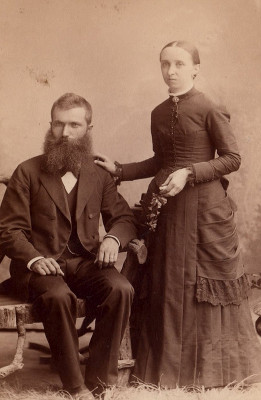 |
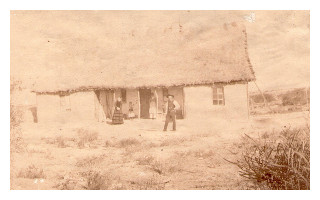 |
||
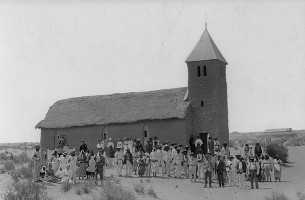 |
|||
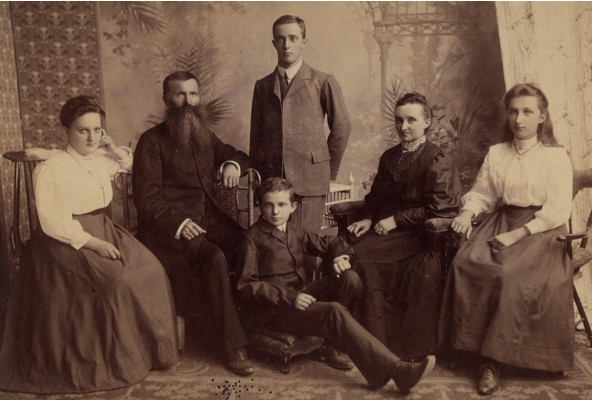 |
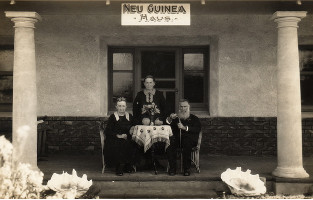 |
||
1 Information regarding Beate Auricht nee Paech (1834-1892) is from Graeme Moad’s very useful website Ancestors, a private genealogical online databank of German migrants in South Australia, http://graememoad.com/web/Ancestors/Ancestors.html, accessed 24 October 2011.
2 Five children were from the father’s first marriage.
3 Memoirs of Johann Flierl original manuscript, Vol I, p. 288. In the following cited as ‘Flierl’ with volume and page number.
In 1940 and 1941 Flierl wrote his 900-page autobiography for his children. Only excerpts have so far been published (My Life and God’s Mission, An Autobiography by Johann Flierl Snr. Pioneer Missionary and Field inspector in New Guinea, translated by Eric Flierl, Adelaide 1999). This publication offers 256 pages of selected passages in English translation, concerning almost exclusively his missionary activity, leaving aside his commentaries on politics, personal memories etc. A full annotated German edition will be published as Als Pioniermissionar in das ferne Neu Guinea. Die Lebenserinnerungen Johann Flierls, edited by Susanne Froehlich (Quellen und Forschungen zur Südsee. Reihe A: Quellen), 2 Volumes, forthcoming (Wiesbaden 2013).
4 The birth of a baby Louise is recorded in the same month, September 1839.
5 Regarding Christian Auricht (1832-1907) I consulted the website cited above and H.F. W. Proeve’s entry in the Australian Dictionary of Biography, http://adb.online.anu.edu.au/biography/auricht-johann-christian-2912, accessed 24 October 2011.
6 See Mi Stori: Frauen erzählen Geschichte. Materials accompanying the exhibition, edited by Mission Eine Welt, Neuendettelsau, 2011, edited by Heide Lienert-Emmerlich.
7 Flierl I:141.
8 (Johann Flierl), Über die Toten nur Gutes! Ein Ehrendenkmal für die ehrwürdigen heimgegangenen Väter der luth. Kirche in Australien. (By an old Australian), self-published, Tanunda, 1929: 11-13. Transl: Only good things about the dead! A homily for the honourable deceased fathers of the Lutheran church in Australia, by an old Australian.
9 Flierl I:154
10 Die Folgezeit zeigte, daß die zarte Blume, aus dem festen zähen Stamm der Kolonistenfamilien der Auricht und Paech entsprossen, auch zäh und fest war und in den Wüsten Australiens und später in den Wildnissen von Neu Guinea sozusagen recht wohl ihren Mann gestanden hat und auch vor Dornen und Ungemach nicht zurückschreckte.“ Flierl I:155. The objection was made by Rechner, according to Flierl’s letter Nr 264 of 7 August 1901, p.4.
11 Flierl I:156f.
12 “im Anwesen bestätigt”, Flierl I:184.
13 Flierl I:216.
14 Flierl I:220. „Ich will Dir dienen und will Dir gehorchen, ich will Dich hegen und will Dich pflegen, Dir treu sein, Dich nicht verlassen, bis daß der Tod uns scheidet.“
15 Flierl I: 218-220.
16 Flierl I:209.
17 Flierl I:224-226.
18 Flierl I:262.
19 Flierl I:234.
20 Flierl I:267.
21 (In memoriam Georg Pfalzer) “Georg Pfalzer im Nachruf: Ein Kranz auf das Grab der lieben Frau Senior Flierl” Concordia Vol 63, 1934:492-295, p.492.
22 Ibid. p.493; Flierl letter Nr 169 of 17 July 1895:2; Flierl II:24.
23 Flierl II:34.
24 In Flierl’s memoirs this fact is subtly ignored (II:51), but in his letter Nr. 172 of 14 September 1895, where he announces the birth to the mission house in Neuendettelsau, he vividly narrates the event.
25 Flierl II:252-254.
26 Flierl II:257
27 Flierl II:258.
28 CF the museum’s new homepage, http://community.history.sa.gov.au/louise-flierl-mission-museum, accessed 4 February 2012.
